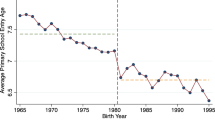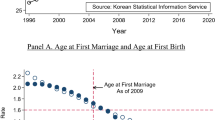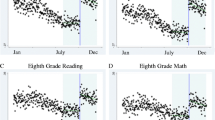Abstract
Many studies show that females’ age at first childbirth affects important outcomes of these females and their offspring such as health- and socioeconomic-related variables. This paper analyzes whether there is a causal relationship between working mothers’ school entry age and the timing at which they give birth by exploiting Korea’s elementary school entry cutoff regulation. Using administrative employment insurance data that record the fertility history of female working mothers together with regression discontinuity design, we find that a year’s delay in age at school starting increases age at first and second childbirth by approximately 3 and 4 months, respectively. We also find that one of the mechanisms that affects the relationship between these two variables is age at first employment. The estimated effects of SSA are likely to be salient in a country where educational sequence that a student experience is rigid.





Similar content being viewed by others
Data availability
We have received the administrative data from the Ministry of Labor in Korea conditional on not disclosing the data. We will assist researchers who are interested in obtaining data from the Institute.
Code availability
We will provide STATA codes for those who are interested in receiving the do file used for creating figures and tables.
Notes
We tested whether the C-section rate affects effect estimates. Specifically, we derived effect estimates when the C-section rate was very low using the 1979–82 cohorts in which the rate is much lower than 1985. The results were qualitatively similar.
Article 15 (Making List of Schoolchildren) of Chapter 2 of the Decree stipulates the following: “The head of an Eup/Myeon/Dong (i.e., administrative district) shall investigate children living in his jurisdiction as of November 1 who reach elementary school age (excluding those who attend school at the age of five pursuant to Article 13 (2) of the Act) on March 1 of the following year and make a list of schoolchildren by November 30 of the year concerned.”.
Article 15 of the Decree was amended as the following: “The head of an Eup/Myeon/Dong shall investigate children living in his/her jurisdiction as of October 1 every year who reach 6 years of age from January 1 to December 31 of the year (excluding those who are going to school by entering an elementary school in the next year of the year to which the date on which they reach 5 years of age belongs pursuant to the forepart of Article 13 (2) of the Act) and make a list of schoolchildren by October 31 of the year. In such cases, children excluded from a list of schoolchildren because they have re-quested postponement of entering a school in the year to which the date on which they reach 6 years of age belongs pursuant to paragraph (3) shall be included therein.”.
Effect estimates based on other kernel functions (e.g., Epanechnikov) and higher-order polynomials are qualitatively similar and available upon requests.
The effect estimate on the timing of first childbirth based on cohorts without the 1979 to 1982 birth cohorts is very similar with the full analysis sample (available upon request). Note, however, that if we drop these cohorts, it would be very difficult to analyze the effect on the timing of second childbirth because our data time frame does not allow for keeping track of second childbirth for later birth cohorts.
Mothers who are born on February 29 are coded as being born on February 28 for the sake of simplicity.
References
Aassve, A., Billari, F. C., & Spéder, Z. (2006). Societal transition, policy changes and family formation: Evidence from Hungary. European Journal of Population, 22(2), 127–152.
Addo, F. R., Sassler, S., & Williams, K. (2016). Reexamining the association of maternal age and marital status at first birth with youth educational attainment. Journal of Marriage and Family, 78(5), 1252–1268.
Adserà, A. (2004). Changing fertility rates in developed countries. The impact of labor market institutions. Journal of Population Economics, 17, 17–43.
Amin, V., & Behrman, J. R. (2014). Do more-schooled women have fewer children and delay childbearing? Evidence from a sample of US Twins. Journal of Population Economics, 27(1), 1–31.
Angrist, J. D., & Krueger, A. B. (1991). Does compulsory school attendance affect schooling and earnings? Quarterly Journal of Economics, 106(4), 979–1014.
Angrist, J. D., & Krueger, A. B. (1992). The effect of age at school entry on educational attainment: An application of instrumental variables with moments from two samples. Journal of the American Statistical Association, 87(418), 328–336.
Arnold, G., & Depew, B. (2018). School starting age and long-run health in the United States. Health Economics, 27(12), 1904–1920.
Barclay, K., & Myrskylä, M. (2016). Advanced maternal age and offspring outcomes: Reproductive aging and counterbalancing period trends. Population and Development Review, 42(1), 69–94.
Becker, G. S. (1960). An economic analysis of fertility. In: Becker, G. S. (Ed.), Demographic and economic change in developed countries (p. 209–240). Princeton University Press.
Becker, G. S. (1981). A treatise on the family. Harvard University Press.
Bedard, K., & Dhuey, E. (2006). The persistence of early childhood maturity: International evidence of long-run age effects. Quarterly Journal of Economics, 121(4), 1437–1472.
Bedard, K., & Dhuey, E. (2012). School-entry policies and skill accumulation across directly and indirectly affected individuals. Journal of Human Resources, 47(3), 643–683.
Black, S. E., Devereux, P. J., & Salvanes, K. G. (2011). Too young to leave the nest? The effects of school starting age. Review of Economics and Statistics, 93(2), 455–467.
Black, D. A., Kolesnikova, N., Sanders, S. G., & Taylor, L. J. (2013). Are children “normal”? Review of Economics and Statistics, 95(1), 21–33.
Bloom, D. E., & Trussell, J. (1984). What are the determinants of delayed childbearing and permanent childlessness in the United States? Demography, 21(4), 591–611.
Blossfeld, H., & Huinink, J. (1991). Human capital investments or norms of role transition? How women’s schooling and career affect the process of family formation. American Journal of Sociology, 97(1), 143–168.
Bongaarts, J., & Feeney, G. (1998). On the quantum and tempo of fertility. Population and Development Review, 24(2), 271–291.
Borra, C., González, L., & Sevilla, A. (2016). Birth timing and neonatal health. American Economic Review, 106(5), 329–332.
Bratti, M., & Cavalli, L. (2014). Delayed first birth and new mothers’ labor market outcomes: Evidence from biological fertility shocks. European Journal of Population, 30(1), 35–63.
Brien, M. J., & Lillard, L. A. (1994). Education, marriage, and first conception in Malaysia. Journal of Human Resources, 29(4), 1167–1204.
Brion, M. J. A., Leary, S. D., Lawlor, D. A., Smith, G. D., & Ness, A. R. (2008). Modifiable maternal exposures and offspring blood pressure: A review of epidemiological studies of maternal age, diet, and smoking. Pediatric Research, 63(6), 593–598.
Buckles, K. S., & Hungerman, D. M. (2013). Season of birth and later outcomes: Old questions, new answers. Review of Economics and Statistics, 95(3), 711–724.
Cattaneo, M. D., Titiunik, R., & Vazquez-Bare, G. (2017). Comparing inference approaches for RD designs: A reexamination of the effect of head start on child mortality. Journal of Policy Analysis and Management, 36(3), 643–681.
Cigno, A. (1991). Economics of the family. Clarendon Press.
Cygan-Rehm, K., & Maeder, M. (2013). The effect of education on fertility: Evidence from a compulsory schooling reform. Labour Economics, 25, 35–48.
Dee, T., & Sievertsen, H. H. (2018). The gift of time? School starting age and mental health. Health Economics, 27(5), 781–802.
Deming, D., & Dynarski, S. (2008). The lengthening of childhood. Journal of Economic Perspective, 22(3), 71–92.
Dhuey, E., Figlio, D., Karbownik, K., & Roth, J. (2019). School starting age and cognitive development. Journal of Policy Analysis and Management, 38(3), 538–578.
Dickert-Conlin, S., & Elder, T. (2010). Suburban legend: School cutoff dates and the timing of births. Economics of Education Review, 29(5), 826–841.
Dobkin, C., & Ferreira, F. V. (2010). Do school entry laws affect educational attainment and labor market outcomes? Economics of Education Review, 29(1), 40–54.
Duncan, G. J., Lee, K. T. H., Rosales-Rueda, M., & Kalil, A. (2018). Maternal age and child development. Demography, 55(6), 2229–2255.
Durkin, M. S., Maenner, M. J., Newschaffer, C. J., Lee, L. C., Cunniff, C. M., Daniels, J. L., Kirby, R. S., Leavitt, L., Miller, L., Zahorodny, W., & Schieve, L. A. (2008). Advanced parental age and the risk of autism spectrum disorder. American Journal of Epidemiology, 168(11), 1268–1276.
Gelman, A., & Imbens, G. (2019). Why high-order polynomials should not be used in regression discontinuity designs. Journal of Business and Economic Statistics, 37(3), 447–456.
Geronimus, A. T., Korenman, S., & Hillemeier, M. M. (1994). Does young maternal age adversely affect child development? Evidence from cousin comparisons in the United States. Population and Development Review, 20(3), 585–609.
Goldstein, J. R., & Cassidy, T. (2014). A cohort model of fertility postponement. Demography, 51(5), 1797–1819.
Gutiérrez-Domènech, M. (2008). The impact of the labour market on the timing of marriage and births in Spain. Journal of Population Economics, 21(1), 83–110.
Fishman, S. H. (2018). Maternal age and offspring’s educational attainment. Journal of Marriage and Family, 80(4), 853–870.
Huang, C., Zhang, S., & Zhao, Q. (2020). The early bird catches the worm? School entry cutoff and the timing of births. Journal of Development Economics, 143, 102386.
Imbens, G. W., & Lemieux, T. (2008). Regression discontinuity designs: A guide to practice. Journal of Econometrics, 142(2), 615–635.
Jacobsson, B., Ladfors, L., & Milsom, I. (2004). Advanced maternal age and adverse perinatal outcome. Obstetrics & Gynecology, 104(4), 727–733.
Johnson, K. J., Carozza, S. E., Chow, E. J., Fox, E. E., Horel, S., McLaughlin, C. C., Mueller, B. A., Puumala, S. E., Reynolds, P., von Behren, J., & Spector, L. G. (2009). Parental age and risk of childhood cancer: A pooled analysis. Epidemiology, 20(4), 475–483.
Kim, Y. J., & Schoen, R. (2000). On the quantum and tempo of fertility: Limits to the bongaarts-feeney adjustment. Population and Development Review, 26(3), 554–559.
Kravdal, Ø., & Rindfuss, R. R. (2008). Changing relationships between education and fertility: A study of women and men born 1940 to 1964. American Sociological Review, 73(5), 854–873.
Lee, D. S., & Lemieux, T. (2010). Regression discontinuity designs in economics. Journal of Economic Literature, 48(2), 281–355.
Leung, M. Y. M., Groes, F., & Santaeulalia-Llopis, R. (2016). The relationship between age at first birth and mother’s lifetime earnings: Evidence from Danish data. PLoS One, 11(1), e0146989.
Leuven, E., & Oosterbeek, H. (2007). The effectiveness of human-capital policies for disadvantaged groups in the Netherlands. In L. Woessmann & P. E. Peterson (Eds.), Schools and the equal opportunity problem, MIT Press.
Lopoo, L. M., & Raissian, K. M. (2012). Natalist policies in the United States. Journal of Policy Analysis and Management, 31(4), 905–946.
Marini, M. M., & Hodsdon, P. J. (1981). Effects of the timing of marriage and first birth of the spacing of subsequent births. Demography, 18(4), 529–548.
Martin, S. P. (2000). Diverging fertility among U.S. Women who delay childbearing past age 30. Demography, 37(4), 523–533.
McAdams, J. M. (2016). The effect of school starting age policy on crime: Evidence from U.S. Microdata. Economics of Education Review, 54, 227–241.
McEwan, P. J., & Shapiro, J. S. (2008). The benefits of delayed primary school enrollment. Discontinuity estimates using exact birth dates. Journal of Human Resources, 43(1), 1–29.
McCrary, J. (2008). Manipulation of the running variable in the regression discontinuity design: A density test. Journal of Econometrics, 142(2), 698–714.
McCrary, J., & Royer, H. (2011). The effect of female education on fertility and infant health: Evidence from school entry policies using exact date of birth. American Economic Review, 101(1), 158–195.
Murphy, M., Martikainen, P., & Pennec, S. (2006). Demographic change and the supply of potential family supporters in Britain, Finland and France in the period 1911–2050. European Journal of Population, 22(3), 219–240.
Myrskylä, M., & Fenelon, A. (2012). Maternal age and offspring adult health: Evidence from the health and retirement study. Demography, 49(4), 1231–1257.
Neels, K., Murphy, M., Ní Bhrolcháin, M., & Beaujouan, É. (2017). Rising educational participation and the trend to later childbearing. Population and Development Review, 43(4), 667–693.
Ní Bhrolcháin, M. (1992). Period paramount? A critique of the cohort approach to fertility. Population and Development Review, 18(4), 599–629.
Ní Bhrolcháin, M. (2011). Tempo and the TFR. Demography, 48(3), 841–861.
Ní Bhrolcháin, M., & Beaujouan, É. (2012). Fertility postponement is largely due to rising educational enrolment. Population Studies, 66(3), 311–327.
Osili, U. O., & Long, B. T. (2008). Does female schooling reduce fertility? Evidence from Nigeria. Journal of Development Economics, 87(1), 57–75.
Raymo, J. M. (2003). Educational attainment and the transition to first marriage among Japanese women. Demography, 40(1), 83–103.
Rindfuss, R. R., Guilkey, D., Morgan, S. P., Kravdal, Ø., & Guzzo, K. B. (2007). Child care availability and first-birth timing in Norway. Demography, 44(2), 345–372.
Rindfuss, R. R., Morgan, S. P., & Offutt, K. (1996). Education and the changing age pattern of American fertility: 1963–1989. Demography, 33(3), 277–290.
Sauer, M. V. (2015). Reproduction at an advanced maternal age and maternal health. Fertility and Sterility, 103(5), 1136–1143.
Schmidt, L., Sobotka, T., Bentzen, J. G., & Nyboe Andersen, A. (2012). Demographic and medical consequences of the postponement of parenthood. Human Reproduction Update, 18(1), 29–43.
Schulkind, L., & Shapiro, T. M. (2014). What a difference a day makes: Quantifying the effects of birth timing manipulation on infant health. Journal of Health Economics, 33, 139–158.
Shoen, R. (2004). Timing effects and the interpretation of period fertility. Demography, 41(4), 801–819.
Silles, M. (2011). The effect of schooling on teenage childbearing: Evidence using changes in compulsory education laws. Journal of Population Economics, 24(2), 761–777.
Skirbekk, V. (2005). Why not start younger? Implications of the timing and duration of schooling for fertility, human capital, productivity, and public pensions. IIASA Research Report.
Skirbekk, V., Kohler, H., & Prskawetz, A. (2004). Birth month, school graduation, and the timing of births and marriages. Demography, 41(3), 547–568.
Sutcliffe, A. G., Barnes, J., Belsky, J., Gardiner, J., & Melhuish, E. (2012). The health and development of children born to older mothers in the United Kingdom: Observational study using longitudinal cohort data. The BMJ, 345, e5116.
te Velde, E., Habbema, D., Leridon, H., & Eijkemans, M. (2012). The effect of postponement of first motherhood on permanent involuntary childlessness and total fertility rate in six European countries since the 1970s. Human Reproduction, 27(4), 1179–1183.
Triunfo, S., Petrillo, F., Lofoco, F., Volpe, M., & Lanzone, A. (2019). Cost analysis for deliveries according to maternal age classes for moving to a personalized approach in the health care. Journal of Maternal-Fetal and Neonatal Medicine., 34, 223–230.
Tropf, F. C., & Mandemakers, J. J. (2017). Is the association between education and fertility postponement causal? The role of family background factors. Demography, 54(1), 71–91.
Wooldridge, J. (2012). Introductory econometrics: A modern approach. Mason, Ohio: South-Western Cengage Learning.
Funding
We did not receive any financial support for the work from any organizations.
Author information
Authors and Affiliations
Corresponding author
Additional information
Publisher's Note
Springer Nature remains neutral with regard to jurisdictional claims in published maps and institutional affiliations.
Supplementary Information
Below is the link to the electronic supplementary material.
Rights and permissions
About this article
Cite this article
Chang, I., Park, H. & Sohn, H. Causal Impact of School Starting Age on the Tempo of Childbirths: Evidence from Working Mothers and School Entry Cutoff Using Exact Date of Birth. Eur J Population 37, 997–1022 (2021). https://doi.org/10.1007/s10680-021-09597-x
Received:
Accepted:
Published:
Issue Date:
DOI: https://doi.org/10.1007/s10680-021-09597-x




